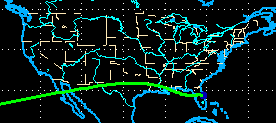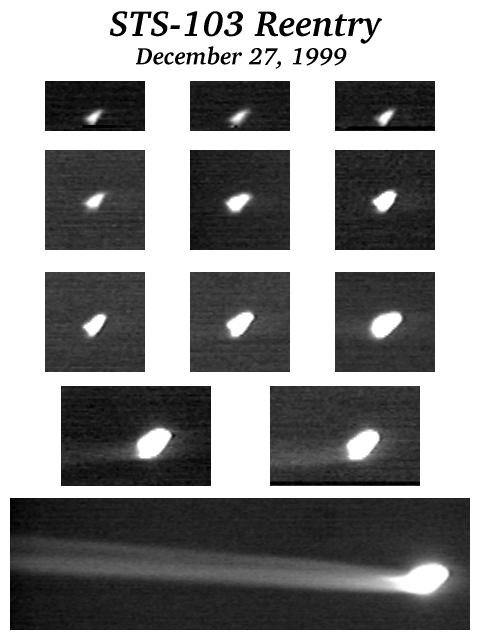
STS-103 returned to Earth on December 27, 1999. The shuttle Discovery passed about 10 degrees above the Northern horizon as seen from Houston. Closest approach to Houston occurred at about 5:46pm CST with landing occuring at 6:01pm CST. Below is the path of Discovery across the Southern U.S. The image is cropped from one on the NASA spaceflight web site.

The following shows frames from a low-light video camera. The images were taken with a Supercircuits PC-23C 0.04 lux grayscale video camera at prime focus of an 8" f/6.3 Meade LX-200 telescope. Exposure times were probably 1/60th of a second. The individual frames were digitized as 8 bit grayscale images and all except the bottom image is composed of a single field from the video interpolated to fill in the alternating gaps. The bottom image is the average of two fields.
Pointing of the telescope was much improved over the attempt for STS-93. The vehicle remained in the field of view for periods of up to one second. Even better, when the shuttle was in the field, there were usually several frames where it was essentially still so no motion blur occurred. Unfortunately the images are still not what I wanted as the orbiter was even farther from Houston than Columbia on STS-93. Also, the sun had just set at 5:29pm CST so the sky was still very bright and the vehicle was probably directly illuminated by it, washing out details of the shock layer. Finally, the shuttle was constantly passing behind thin, low clouds.
There was a silver lining to the clouds, however. Since the shuttle passed Houston just after sunset, the orbiter was probably in sunlight. At any rate, it is overexposed in the images below. When passing behind the clouds, however, the light level was reduced allowing more detail near the orbiter to be seen. The set of photos below shows the appearance of the vehicle as it passed behind different thicknesses of clouds. Near the top, the clouds were thick and what may be the shuttle itself can be seen. As the clouds thin, the orbiter became overexposed with the image growing in size. Finally, the one image at the bottom is very overexposed but it yields a decent view of the wake behind the vehicle.

In all of the photos above, the shuttle is moving almost exactly left to right and the vehicle is in a 57 degree right bank. The approximate orientation during the middle of the flyover should have been similar to that in the drawing below.

| Return to Home Page | Latest update: December 29, 1999 |